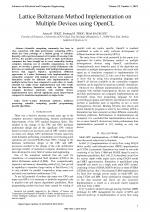| 3/2018 - 1 | View TOC | « Previous Article | Next Article » |
Lattice Boltzmann Method Implementation on Multiple Devices using OpenCLTEKIC, J. B. |
| Extra paper information in |
| Click to see author's profile in |
| Download PDF |
Author keywords
Lattice Boltzmann methods, multicore processing, scientific computing, parallel programming, parallel algorithms
References keywords
lattice(21), boltzmann(21), method(11), multi(8), simulations(6), flow(6), flows(5), computational(5), time(4), relaxation(4)
Blue keywords are present in both the references section and the paper title.
About this article
Date of Publication: 2018-08-31
Volume 18, Issue 3, Year 2018, On page(s): 3 - 8
ISSN: 1582-7445, e-ISSN: 1844-7600
Digital Object Identifier: 10.4316/AECE.2018.03001
Web of Science Accession Number: 000442420900001
SCOPUS ID: 85052088705
Abstract
Scientific computing community has been in close connection with high performance computing (HPC), which has been privilege of a limited group of scientists. Recently, with rapid development of Graphics Processing Units (GPUs), the parallel processing power of high performance computers has been brought up to every commodity desktop computer, reducing cost of scientific computations. In this paper, we develop a general purpose Lattice Boltzmann code that runs on commodity computer with multiple heterogeneous devices that support OpenCL specification. Different approaches to Lattice Boltzmann code implementations on commodity computer with multiple devices were explored. Simulation results for different code implementations on multiple devices have been compared to each other, to results obtained for single device implementation and with results from the literature. Simulation results for the commodity computer hardware platforms with multiple devices implementation have showed significant speed improvement compared to simulation implemented on single device. |
| References | | | Cited By |
Web of Science® Times Cited: 2 [View]
View record in Web of Science® [View]
View Related Records® [View]
Updated today
SCOPUS® Times Cited: 2
View record in SCOPUS® [Free preview]
View citations in SCOPUS® [Free preview]
[1] GPU-powered, interactive flow simulation on a peer-to-peer group of mobile devices, Harwood, Adrian R. G., Advances in Engineering Software, ISSN 0965-9978, Issue , 2019.
Digital Object Identifier: 10.1016/j.advengsoft.2019.04.003 [CrossRef]
[2] Performance Comparison of Different OpenCL Implementations of LBM Simulation on Commodity Computer Hardware, TEKIC, J., TEKIC, P., RACKOVIC, M., Advances in Electrical and Computer Engineering, ISSN 1582-7445, Issue 1, Volume 22, 2022.
Digital Object Identifier: 10.4316/AECE.2022.01008 [CrossRef] [Full text]
Disclaimer: All information displayed above was retrieved by using remote connections to respective databases. For the best user experience, we update all data by using background processes, and use caches in order to reduce the load on the servers we retrieve the information from. As we have no control on the availability of the database servers and sometimes the Internet connectivity may be affected, we do not guarantee the information is correct or complete. For the most accurate data, please always consult the database sites directly. Some external links require authentication or an institutional subscription.
Web of Science® is a registered trademark of Clarivate Analytics, Scopus® is a registered trademark of Elsevier B.V., other product names, company names, brand names, trademarks and logos are the property of their respective owners.
Faculty of Electrical Engineering and Computer Science
Stefan cel Mare University of Suceava, Romania
All rights reserved: Advances in Electrical and Computer Engineering is a registered trademark of the Stefan cel Mare University of Suceava. No part of this publication may be reproduced, stored in a retrieval system, photocopied, recorded or archived, without the written permission from the Editor. When authors submit their papers for publication, they agree that the copyright for their article be transferred to the Faculty of Electrical Engineering and Computer Science, Stefan cel Mare University of Suceava, Romania, if and only if the articles are accepted for publication. The copyright covers the exclusive rights to reproduce and distribute the article, including reprints and translations.
Permission for other use: The copyright owner's consent does not extend to copying for general distribution, for promotion, for creating new works, or for resale. Specific written permission must be obtained from the Editor for such copying. Direct linking to files hosted on this website is strictly prohibited.
Disclaimer: Whilst every effort is made by the publishers and editorial board to see that no inaccurate or misleading data, opinions or statements appear in this journal, they wish to make it clear that all information and opinions formulated in the articles, as well as linguistic accuracy, are the sole responsibility of the author.





